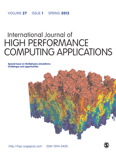
INTERNATIONAL JOURNAL OF HIGH PERFORMANCE COMPUTING APPLICATIONS
Scope & Guideline
Exploring Cutting-Edge Developments in Computing
Introduction
Aims and Scopes
- High-Performance Algorithms and Libraries:
Research on the development and optimization of algorithms and libraries that enhance computational performance, including linear algebra, iterative solvers, and specialized libraries for GPUs and CPUs. - Exascale Computing Solutions:
Focus on methodologies and tools that facilitate exascale computing, addressing challenges such as performance scalability, resource management, and application portability. - Parallel Computing Techniques:
Exploration of parallel computing paradigms, including MPI, OpenMP, and hybrid programming models that leverage multi-core and many-core architectures for improved performance. - Data-Driven Performance Optimization:
Utilization of machine learning and data analysis techniques to optimize performance in high-performance computing environments, including workload characterization and scheduling. - Scientific Application Development:
Development of computational frameworks and methodologies for specific scientific applications, such as climate modeling, fluid dynamics, and molecular dynamics, emphasizing performance and accuracy. - Interdisciplinary Approaches:
Integration of HPC with other fields such as AI, data science, and materials science to address complex computational problems and enhance the capability of scientific simulations.
Trending and Emerging
- Exascale Computing Challenges:
An increasing number of studies are addressing the unique challenges posed by exascale computing, including resource management, performance optimization, and application scalability, reflecting the community's focus on future computing architectures. - Machine Learning and AI Integration:
The integration of machine learning and artificial intelligence into HPC applications is a growing trend, with research exploring how these technologies can enhance performance, automate workflows, and improve decision-making processes. - Heterogeneous Computing Environments:
A significant emphasis on heterogeneous computing, combining CPUs, GPUs, and specialized hardware, is evident, as researchers seek to optimize performance across diverse architectures. - Advanced Visualization Techniques:
Emerging studies focus on advanced visualization techniques for large-scale data generated by HPC applications, enhancing the ability to interpret complex results effectively. - Sustainable and Energy-Efficient Computing:
Research is increasingly directed towards sustainability and energy efficiency in HPC, exploring methods to reduce the carbon footprint and improve the energy performance of high-performance computing systems.
Declining or Waning
- Traditional CPU-based Computation:
There has been a noticeable decrease in research focused solely on traditional CPU-based computing methods, as the shift towards GPU and heterogeneous computing becomes more pronounced. - Basic Numerical Methods:
Research centered on fundamental numerical methods without significant enhancements or optimizations is becoming less common, as the community increasingly emphasizes advanced, application-specific solutions. - Legacy Software Systems:
The study of legacy software systems and their optimization has waned, with a greater emphasis now placed on developing new architectures and programming models tailored for modern HPC environments. - Non-Exascale Applications:
Investigations into non-exascale applications are less frequently published, reflecting a trend towards tackling the challenges presented by exascale computing and its associated complexities. - Generalized Performance Metrics:
Research that focuses on generalized performance metrics without context-specific applications is declining, as more studies emphasize targeted performance improvements for specific applications or architectures.
Similar Journals

Journal of Grid Computing
Pioneering Discoveries in Collaborative ComputingThe Journal of Grid Computing, published by Springer, stands as a pivotal resource in the dynamic field of computer science, particularly within the realms of Computer Networks and Communications, Hardware and Architecture, Information Systems, and Software. With an impressive Q1 ranking across these categories in 2023, the journal exemplifies excellence and rigor, catering to a diverse readership from researchers to industry professionals. Established in 2003, this esteemed journal is anchored in the Netherlands and releases cutting-edge research that reflects trends and advancements in grid computing technologies. Researchers can gain insights through its vast contributions, while institutions benefit from its prestigious standing within the SCOPUS framework, boasting high percentile ranks in multiple computer science categories. Though not open access, the journal provides unparalleled access options for institutional subscribers, solidifying its importance as a gateway to innovative discoveries in high-performance distributed computing.
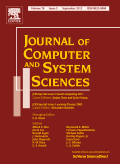
JOURNAL OF COMPUTER AND SYSTEM SCIENCES
Championing cutting-edge research in computational theory.The Journal of Computer and System Sciences is a distinguished publication founded in 1967 and continually striving to push the boundaries of knowledge in computer science and applied mathematics. Published by Academic Press Inc, Elsevier Science, this journal boasts impressive credentials, holding a Q1 quartile ranking across multiple categories including Applied Mathematics, Computational Theory and Mathematics, Computer Networks and Communications, and Theoretical Computer Science as of 2023. With a focus on innovative research and comprehensive theoretical developments, this journal serves as a pivotal forum for authors and readers alike, facilitating cutting-edge contributions to the field. The journal is not currently open access, providing a curated selection of high-quality articles for its subscription residents. By engaging with this journal, researchers, professionals, and students can gain insight into the latest trends, prominent methodologies, and significant findings that shape the modern landscape of computing and systems analysis.
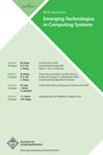
ACM Journal on Emerging Technologies in Computing Systems
Shaping Tomorrow's Technology Landscape TodayACM Journal on Emerging Technologies in Computing Systems, published by the Association for Computing Machinery, stands as a premier platform dedicated to the exploration and discussion of avant-garde advancements in computing systems. With an ISSN of 1550-4832 and an E-ISSN of 1550-4840, this journal has achieved notable recognition, holding a 2023 Q2 ranking in key fields such as Electrical and Electronic Engineering, Hardware and Architecture, Nanoscience and Nanotechnology, and Software. Spanning from 2005 to 2024, it provides a critical forum for researchers, professionals, and students alike to disseminate innovative research and applications that shape the future of technology. Although currently not open access, the journal's commitment to high-quality, peer-reviewed content ensures its relevance and impact, as reflected in its competitive Scopus ranks across various disciplines. Engage with groundbreaking research that propels the frontiers of computational systems in this dynamic academic journal.
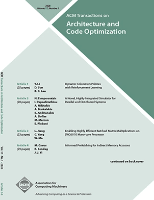
ACM Transactions on Architecture and Code Optimization
Fostering Excellence in Hardware and Software ResearchACM Transactions on Architecture and Code Optimization, published by the Association for Computing Machinery (ACM), serves as a premier journal in the fields of architecture, hardware, and software optimization. With an ISSN of 1544-3566 and E-ISSN of 1544-3973, this journal provides a platform for innovative research and discussion from 2004 to 2024, reflecting its commitment to the evolving landscape of computer science. Holding a Q2 ranking in key categories such as Hardware and Architecture, Information Systems, and Software, it stands out in its field, catering to a broad audience of researchers, professionals, and students alike. While the journal does not currently offer open access, subscribers can benefit from an array of valuable insights into cutting-edge techniques for optimizing code and architectural designs. Its rigorous peer-review process ensures that only high-quality, impactful research is published, making it an essential resource for those seeking to advance their knowledge and practice in these vital areas of computing.
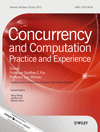
CONCURRENCY AND COMPUTATION-PRACTICE & EXPERIENCE
Driving Innovation through Open Access ScholarshipCONCURRENCY AND COMPUTATION-PRACTICE & EXPERIENCE, published by Wiley in the United Kingdom, serves as a pivotal platform for advancing research and innovation in the fields of computational theory, computer networks, and practical applications of computer science. With an impressive impact factor and recognition in the Q2 category for disciplines such as Computational Theory and Mathematics, this journal attracts a diverse range of scholarly articles that address the current challenges and developments in these areas. It boasts a comprehensive viewership with options for Open Access, enabling wide dissemination of knowledge. Indexed by Scopus with notable rankings in multiple categories, including a remarkable position in Computational Theory and Mathematics (Rank #41/176), the journal not only elevates academic discourse but also fosters collaboration among researchers, professionals, and students alike. As it progresses toward its 2024 milestone, CONCURRENCY AND COMPUTATION-PRACTICE & EXPERIENCE remains dedicated to publishing high-quality research that prepares its readership for the evolving technological landscape.
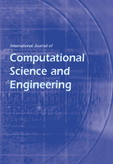
International Journal of Computational Science and Engineering
Fostering Interdisciplinary Insights in Engineering and ScienceThe International Journal of Computational Science and Engineering, published by InderScience Enterprises Ltd, is a premier platform dedicated to the interdisciplinary field of computational science and engineering. With an ISSN of 1742-7185 and an E-ISSN of 1742-7193, the journal has been serving the academic community since its establishment in 2005 and will continue to do so until 2024. Notably categorized in the Q3 quartile for various domains, including Computational Mathematics, Software, and Hardware and Architecture, it holds respectable rankings in Scopus, evidencing its importance in advancing research and practice. While the journal is not open-access, it offers subscription options that ensure wide dissemination among researchers, professionals, and students. The journal aims to publish high-quality original research articles, survey papers, and case studies that contribute to the theoretical and practical aspects of computational techniques and methodologies. In a rapidly evolving digital landscape, this journal is a valuable resource for those seeking to push the boundaries of knowledge in computational science.
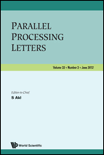
Parallel Processing Letters
Fostering Collaboration in Hardware and Software Research.Parallel Processing Letters is a notable academic journal published by World Scientific Publishing Co Pte Ltd, focusing on the dynamic fields of Computer Science, particularly in Hardware and Architecture, Software, and Theoretical Computer Science. Established in 1994, this journal provides a platform for the dissemination of cutting-edge research and developments in parallel processing and computational technologies. Despite its current Q4 ranking in multiple categories, Parallel Processing Letters plays an important role in fostering scholarly discussion and innovation within the computing community. With the ISSN 0129-6264 and E-ISSN 1793-642X, the journal is dedicated to maintaining rigorous academic standards while encouraging collaborative research conducive to the advancement of parallel processing systems. It serves as a valuable resource for researchers, professionals, and students seeking to deepen their understanding and gain insights into this rapidly evolving domain.
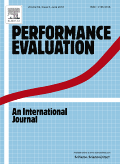
PERFORMANCE EVALUATION
Uncovering Insights in Computer Networks and BeyondPERFORMANCE EVALUATION, published by ELSEVIER, is a prestigious journal that serves as a critical resource for researchers and professionals in the fields of Computer Networks and Communications, Hardware and Architecture, Modeling and Simulation, and Software. With its ISSN 0166-5316 and E-ISSN 1872-745X, this journal is recognized for its contribution to the advancement of performance assessment methodologies and empirical research. Holding a Q3 quartile ranking across multiple categories in 2023, PERFORMANCE EVALUATION is positioned as a valuable platform for disseminating high-quality studies that explore complex performance issues and innovative solutions. Operating from its base in the Netherlands, this journal emphasizes rigorous peer-review standards and enhances its relevance within the academic community by addressing crucial challenges and trends in technology. Stakeholders can access the wealth of knowledge published from 1981 through 2024 by exploring this journal, making it an essential tool for practitioners and scholars aiming to stay at the forefront of computer science research.
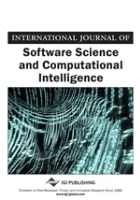
International Journal of Software Science and Computational Intelligence-IJSSCI
Exploring New Dimensions in Software Engineering and AIInternational Journal of Software Science and Computational Intelligence (IJSSCI) is a prominent academic journal published by IGI Global, dedicated to advancing the fields of software science and computational intelligence. With its ISSN 1942-9045 and E-ISSN 1942-9037, IJSSCI offers a platform for researchers, practitioners, and students to disseminate innovative research findings, theoretical advancements, and practical applications in areas such as algorithm development, machine learning, and software engineering. Although the journal currently does not operate under an open access model, its rigorous peer-review process ensures high-quality publications that contribute significantly to the academic discourse. Based in Hershey, PA, IJSSCI is recognized for its commitment to fostering collaboration among professionals in the technology and computer science fields, making it an essential resource for those looking to stay at the forefront of software science advancements.

Journal of Cloud Computing-Advances Systems and Applications
Unveiling the Power of Cloud ApplicationsThe Journal of Cloud Computing - Advances Systems and Applications, published by Springer, serves as a premier platform for disseminating cutting-edge research in the fields of cloud computing, computer networks, and software technologies. With an impressive impact factor and ranked in the top quartile for Computer Networks and Communications and Software categories in 2023, this open access journal has gained significant recognition within the academic community since its establishment in 2012. The journal not only provides valuable insights into innovative applications and advancements in cloud technologies but also supports collaboration among scholars, practitioners, and industry leaders. Operating from the vibrant hub of New York City, it boasts a robust international readership, ensuring that the latest findings reach a diverse audience. Authors and researchers are encouraged to engage with this vital resource, which is dedicated to exploring the transformative potential of cloud computing across multiple disciplines.